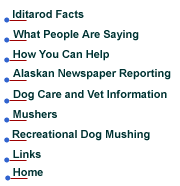
The
Iditarod's policy and program of testing mushers for drugs is a total
sham. Iditarod officials don't even get the results of the drug tests
until many days after the race has ended. As a result, mushers who used
banned substances can't be disqualified from the race when they tested
positive. Under Iditarod "Rule 29-Use of Drugs and Alcohol," (Rule #30
in 2012) violators of the race's drug and alcohol policy may be ineligible
to participate for a specified period of time in future races. It's important
to note that the Iditarod didn't commit to punish violators of its rule,
and it didn't commit itself to report illegal activity to local authorities.
For 26 years the Iditarod ignored its own drug testing policy. In 2010,
Stan Hooley, executive director of the Iditarod Trail Committee, announced
that all mushers would be tested along the trail. But that's not what
happened. Top mushers were tested for drugs at White Mountain, which is
the second-to-last checkpoint. Other mushers were tested after they crossed
the finish line in Nome. The 16 mushers who dropped out of the race at
various places along the trail were never given drug tests. In 2011, the
47 finishers were tested for drugs at the White Mountain checkpoint. The
15 mushers who didn't finish the race weren't tested for drugs.
Before the start of the 2010 race, executive director Stan Hooley said
that any positive drug tests results would be announced and violators
would be named. Forty-seven days after the Iditarod ended, he revealed
that two mushers who finished in the bottom 15 tested positive for Tetrahydrocannabinol
(THC), the main psychoactive ingredient in marijuana. Race officials refused
to identify the mushers who tested positive and refused to sanction them.
According to the Iditarod's website, the following 15 mushers finished
in the bottom 15: Cindy Gallea, Sam Deltour, Blake Freking, Tamara Rose,
Arthur Church, Jr., Wattie McDonald, Lachlan Clarke, Newton Marshall,
Billy Snodgrass, Trent Herbst, Chris Adkins, Dave DeCaro, Ross Adam, Jane
Faulkner and Scott White. The test results for the last seven finishers
in 2011 hasn't been published.
The Iditarod Trail Committee did not publish the list of prohibited drugs
on its website for the 2010 and 2011 races. But here's what we do know:
In August 2009, the Iditarod Board of Directors voted to adopt the list
of prohibited drugs, as presented at its meeting. On the list were "marijuana,
cocaine, amphetamine/methamphetamine, opiates (codeine/morphine) and synthetic
opiates (hydrocodone, hydromorphone, oxycodone, oxymorphone) and propoxyphene."
This list is not in compliance with the World Anti-Doping Agency's Code
or International Standards, including its list of "Substances and Methods
Prohibited at all Times (In-And Out-Of Competition)."
The Iditarod Board's list of prohibited drugs certainly isn't all inclusive.
Is it possible for any list to include every drug? "You can test for designer
drugs, but only if you know what you're looking for," said Jon Danaceau,
an associate toxicologist at the University of Utah Center for Human Toxicology.
Sophisticated tests can't always tell the difference between synthetic
versions of what the body already makes. And there are so many new drugs
that testers can't keep up. Gene doping is on the horizon and that's almost
impossible to detect.
Drug testing still makes sense even though it has its limits. The Iditarod
should do whatever it takes to ensure the health and welfare of the dogs.
Mushers who suffer adverse effects from drugs will most likely do a worse
job of caring for their animals. The best we can hope for is that the
Iditarod adopts the World Anti-Doping Agency's Code and International
Standards, and that the Iditarod examines mushers before the race and
at every checkpoint, and vows to report and punish violators.
- Margery Glickman, Director, Sled Dog Action Coalition
|
|
Mushers | Recreational Mushing | Links | Home |
Receive our alerts
Contact SDAC: [email protected]
© 2011 SDAC